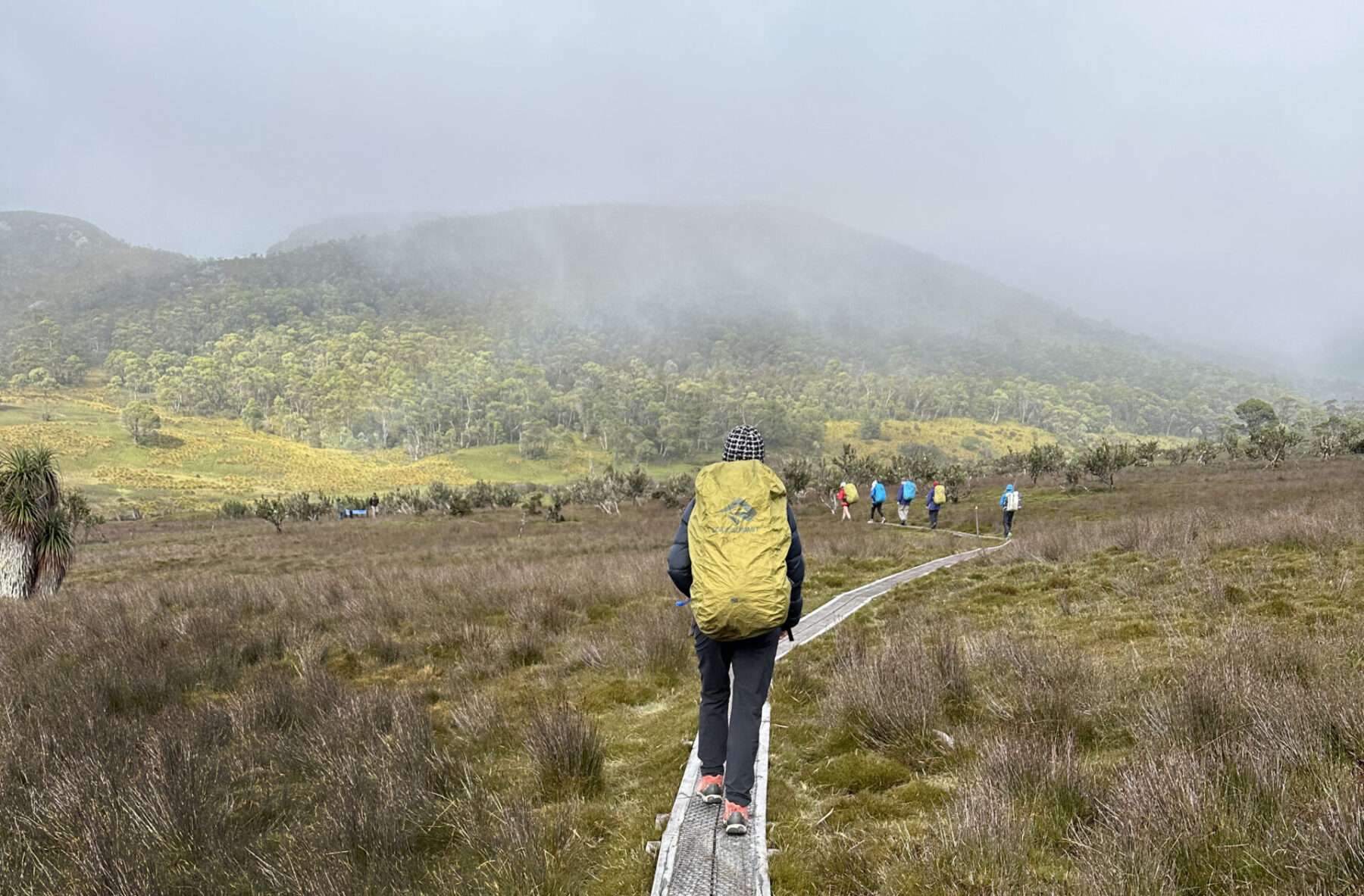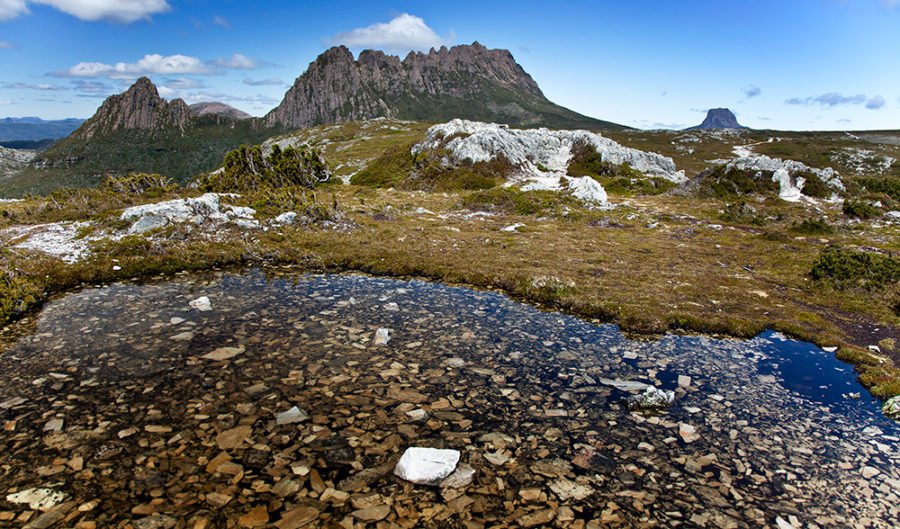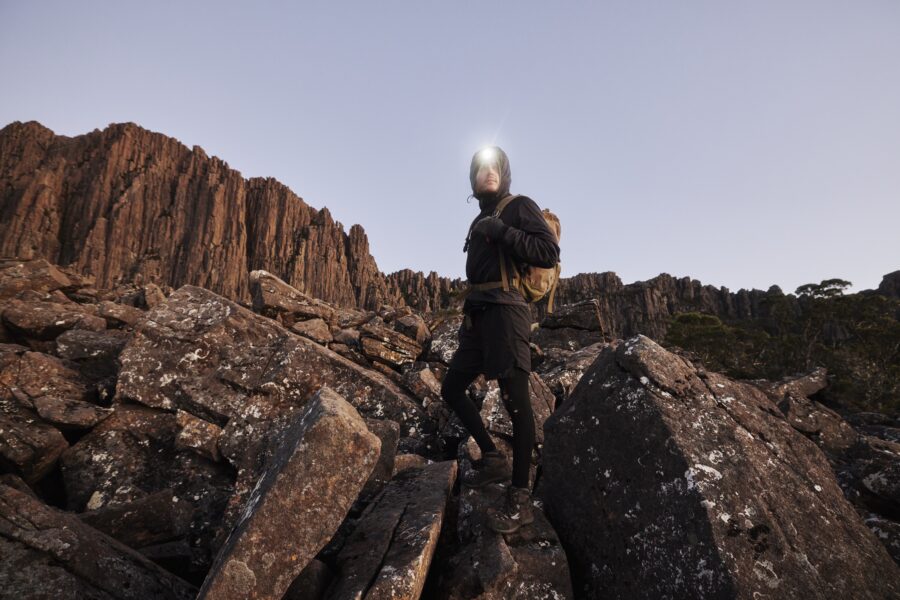It’s Day 6 and we’re sitting down to our final breakfast together – oatmeal garnished with sultanas, almonds and honey; chunky slices of freshly baked fruit toast with lashings of butter (if you’re so inclined); and steaming coffee, a selection of teas and juice. Just the fuel we need to power through our last 10km to meet the ferry at Lake St Clair, our journey’s end.
Gathered around the table are Rob and Izzy, both from Adelaide and at different ends of the age spectrum; Ian and Liz, newly dating and charmingly enamoured; Jan and Kim, best friends for life from Victoria; Michael and Alanah, seasoned Blue Mountains walkers and delightfully engaging; the brilliantly dry-witted Nell, en route from “Brisvegas” to Canberra after our Tassie wander; and me.
Skilfully preparing and serving the feast are our cooks/hiking guides/first-aiders/all-round golden humans – Danah (a passionate botanist); Shawn (a skilled photographer); and Angus (what he doesn’t know, I’ll never know).


Gathered around the communal dining table – crafted from fallen timber sourced in the surrounding forest – The Breakfast Club discusses the day to come, and in the evening, the day that was. All food on the track is provided, as is bedding, so hikers need only carry their personal kit. This means lighter packs and, many would argue, a lighter load all round; Dedicated eco huts are a welcome day’s end relief.
The mood is a little heavier than on previous mornings. We’re all a little melancholy. The days have slipped by with the kilometres and none of us are quite ready to leave the wilds and step back into our daily lives.
“Stay with the forest today,” Danah says. “Savour every moment, and don’t let your mind leap forward. Let the rest of the world wait a while longer.”
It’s sage advice, and as we wind our way from Windy Ridge Hut to Narcissus Hut (from where the Ida Clair will ferry us 17km to Cynthia Bay), the banter and chit-chat of previous days are no longer a constant. Often we stoop to examine boldly coloured fungus popping through the leaf litter, stop to listen to melodious bird calls and crane our necks to admire the stately appendages of the glorious alpine yellow gum.
So, let’s start at the beginning…
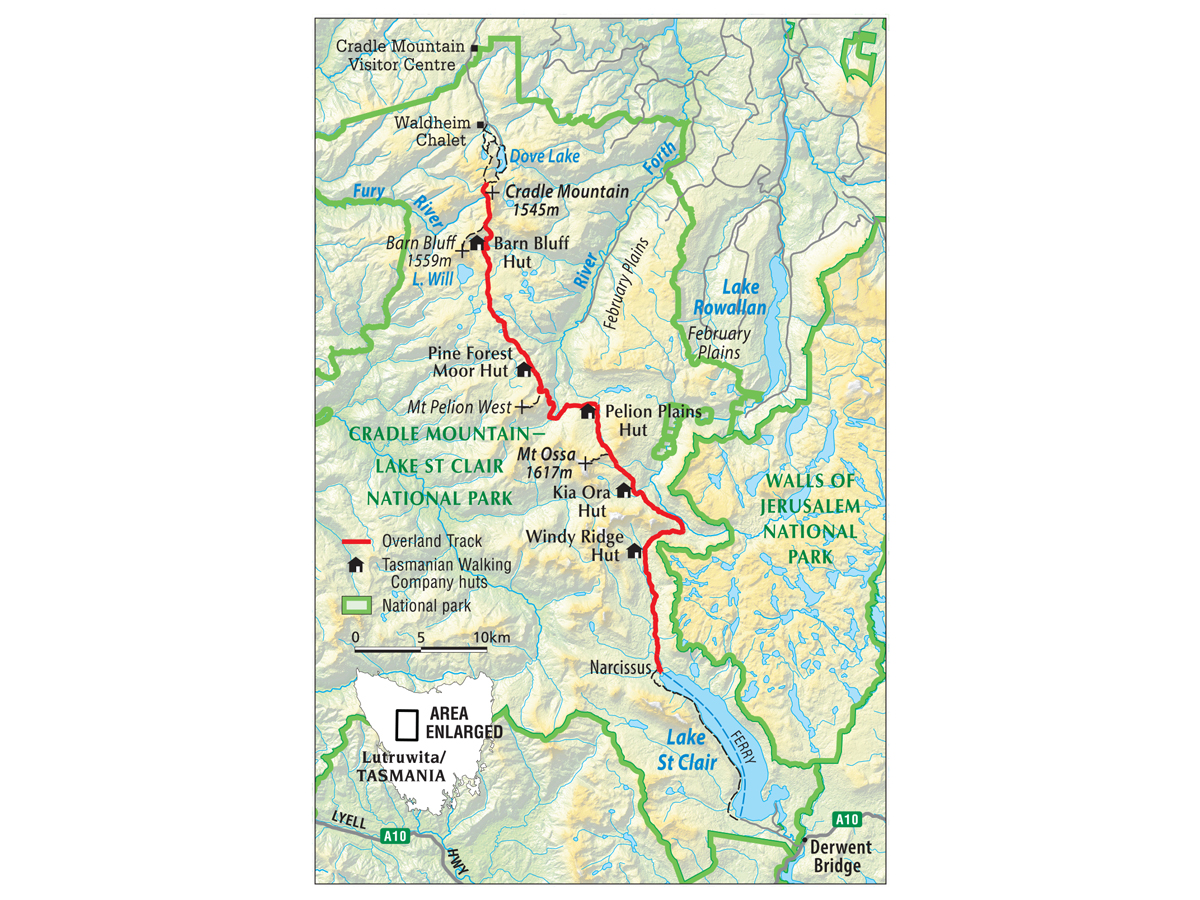
Day 1, 7am:
The Red Feather Inn, about 12 minutes drive from downtown Launceston, is base camp for the Tasmanian Walking Company’s (TWC) Overland Track trekkers. I’d arrived mid-afternoon the day before and revelled in stretching my legs along a wending country track strewn with autumn-hued leaf fall. The thump-thump of pademelons dashing through the bramble only added to the charm.
It’s also gear-central and where I meet my fellow walkers as backpacks and wet-weather gear are handed out. Our sleeping kit and food are already on the track, in the TWC’s custom-built eco huts (five in total, strategically dotted en route).


Crinkle-cut leaves of the native beech (Nothofagus gunnii) festoon the track in autumn. Its roots, which cling to rocks and cliff tops, afford it the name “tanglefoot”; hike host and botanist Danah Leary stands, dwarfed, by King Billy pines (Athrotaxis selaginoides).
On the bus ride to the start of the walk (about two hours), Danah asks us to introduce ourselves and name our favourite plant (great fodder for a botanist). “Eucalypt” is a popular choice. When my turn comes, I pipe “the fagus”. I’ve been writing about Cradle Mountain–Lake St Clair National Park’s native beech (Nothofagus gunnii) for AG for as long as I can remember, particularly enamoured of its crinkled potato-crisp leaves, which morph to gold, orange and blazing red in the autumn, and its wily roots that creep over rocks and cling precariously to cliff tops, gaving rise to its common name, tanglefoot. “You’re in for a treat today then,” Danah says. “We’re in the heart of the season. Once we reach Crater Lake, it’ll be ablaze.”
We walk 12km, starting at Waldheim, the track’s northern head and, in typical Tassie fashion, experience sun, cloud, mizzle and then driving rain (the wet-weather gear worked a treat). We wind through buttongrass plains (hello, wombats), temperate rainforest (I spy celery top pines, sassafras and, hurrah, tanglefoot!), and up to Marions Lookout (at 1223m, the steepest part of the climb includes a chain to help you haul up). We break for lunch at Kitchen Hut (strictly day use only, and a welcome respite from the dropping temperatures) and make a dash for Barn Bluff Hut, our day’s end. While the wind and rain bluster outside, we’re treated to wine, cheese, crackers and a two-course meal, all after a hot shower. This is Overland trekking in style.
Days 2–3, 7am:
Both mornings dawn cold and clear, acquiescing to broad blue skies and temps that hit the teens. The Breakfast Club meets and, while fuelling up, listens to the day’s briefing; a reel of highlight upon highlight.

It is a steep ascent to the 1223m-high Marions Lookout.
With the peaks of Cradle Mountain and Barn Bluff behind us, we make for Mt Pelion West, taking a side track to Lake Will that is skirted by pencil pines and, further on, plunging into the icy depths of Lake Windermere. We descend through gorgeous myrtle-beech rainforest to the base of Mt Pelion West and down further to the Forth River, the Overland’s lowest point. Then we climb, gently, through thick eucalypt forest to reveal Pelion Plains. Uninterrupted views of Mt Oakleigh’s dolerite spires inspire, and an abandoned copper mine harks to bygone days. By nightfall on Day 3, we’ve our feet up, surrounded by dry sclerophyll forest at Pelion Plains Hut.
Day 4, 7am:
Today’s the day – 1617m to the summit of Mt Ossa, Tasmania’s highest peak. The Breakfast Club’s chatter centres on the climb: who’s in, who isn’t, who’s undecided. Shawn, Angus and Danah assure us we can do it; we’ve proven our mettle and “the views and the sense of accomplishment are spectacular”. Plus, the weather’s sublime. And so we go.


Blue, green, gold, pastel… the Overland is a many splendid mix of alpine lakes, craggy bluffs, buttongrass plains, ancient trees and so much more. Swim in Lake Will (left), or bathe in the glow of glorious sunsets (right).
It’s a climb through ancient rainforest – tangled and gnarled, moss-covered and “fungified” – to Pelion Gap. We down our packs, cover them to keep the cheeky currawongs at bay, and hit the track to the Japanese Gardens on the southern slopes of Mt Doris. We lunch here, sitting among a symphony of tiny cushion plants and bonsaied endemic ancient pines, before crossing the southern saddle to Ossa. Following track markers, we climb some more before scrambling over massive boulders and under impressive dolerite spires to reach the mountain’s penultimate peak. From there, it’s rock-hopping to the summit, and extraordinary views over Tassie’s rooftop. I linger by a tarn, marvelling at the cotton-ball clouds reflected in its glass-like stillness, while others leap from boulder to boulder, and I find a solo spot to sit and meditate. To the west, a procession of peaks rise and fall, all the way to the sea.
Day 5, 7am:
There are weary limbs at Breakfast Club this morning. Yesterday’s ascent added five hours of walking (nine in total), and we arrived at Kia Ora Hut well after dark. But no-one minded much, bathing, as we went, in the glory of our climb, the pastel sunset across buttongrass plains and pandani, and, later still, a sky full of dancing Southern Lights.
“Today’s all about waterfalls and ancient forest – the King Billys here are as much as 2000 years old,” Danah says. “But my favourite part of today is our silent walk. Take your time, look up, for sure, but don’t miss the beauty at your feet.”

Dove Lake and Cradle Mountain reveal themselves.
At Du Cane Hut, built in 1910 and a remnant of the long-gone days of animal trapping, we peel off, one by one and five minutes apart.
The pickings are rich. Trees stretch and streams babble, moss runs riot over fallen trunks and fungi spring from everywhere – orange, red, green, blue, mauve, gold, white and Alice in Wonderland. Curiouser and curiouser!
Day 6, Noon:
One by one we swing our way across the suspension bridge that straddles Narcissus River, cheering each other on. It’s celebratory, of course – we’re nearing the end of one of Australia’s most iconic, and challenging, multi-day hikes – but it’s something else, too.
I ponder this as we go, silently, towards the Ida Clair and our journey’s end. Six days ago we’d met, as strangers, over breakfast. Some 65km later, we are members of a very special club.
Together we’ve walked, talked, swam, snored, climbed, laughed and, dare I say it, cried. Our cheers are for all of that, and, as Danah had reminded us this morning, for staying in the moment.
Liz Ginis joined this special botanical Overland Track trip courtesy of the Tasmanian Walking Company.
One last bowl of oatmeal, anyone?
